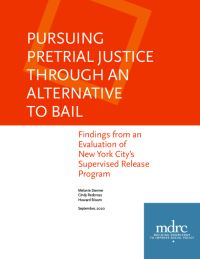Pursuing Pretrial Justice Through an Alternative to Bail
Findings from an Evaluation of New York City’s Supervised Release Program

On any given day in the United States, nearly half a million people are detained in jail while awaiting the resolution of their criminal cases, many because they cannot afford to pay bail. Bail is meant to ensure that defendants appear for court dates and are not arrested for new charges while they wait for their cases to be resolved. However, research has shown that setting bail as a condition of release can lead to unequal treatment and worse outcomes for defendants who do not have the ability to pay, regardless of the risk they pose. Additionally, systemic racial inequities throughout the criminal justice system mean that communities of color are disproportionately affected by cash bail and pretrial detention.
In 2016, New York City rolled out a citywide program known as Supervised Release (SR). SR offers judges the option of releasing defendants under supervision in lieu of setting bail. Defendants released to SR are required to report to program staff members regularly and are offered reminders of their court dates, case management support services, and voluntary connections to social services. The city developed the SR program to reduce the number of defendants detained in jail because they could not afford to pay bail, while at the same time maintaining court appearance rates and public safety. The findings presented in this report offer strong evidence that SR achieved these overarching goals.
The vast majority of defendants in New York City were not considered for SR during the time of this study because the program targeted and screened for eligibility only those defendants facing misdemeanors or nonviolent felony charges who were likely to have bail set and for whom it was believed a judge would be willing to grant SR. The directly measurable effects of SR described in this report therefore apply only to the relatively small proportion of citywide defendants enrolled in the SR program. These findings include:
- Presenting judges the option of SR substantially reduced money bail and pretrial detention.
- SR produced comparable reductions in releases without conditions.
- SR enrollees were subject to court rules that are applied to defendants with open cases for significantly longer time periods. Nevertheless, they were not significantly more likely to have a bench warrant issued for failing to appear for a court date.
- SR did not increase arrests for new crimes during the nine months following case initiation.
- SR enrollees were less likely to be convicted and more likely to have their cases dismissed.
- SR’s effects on money bail, pretrial detention, bench warrants, and new felony arrests did not differ meaningfully among defendants of different races/ethnicities or ages.
- When SR was presented as an option, judges assigned more than half of defendants to it.
- SR largely succeeded at enrolling its intended target population of moderate-risk defendants.
- SR focused more on clients’ social service needs than many other pretrial supervision programs — an aspect that made the program appealing to some judges.






